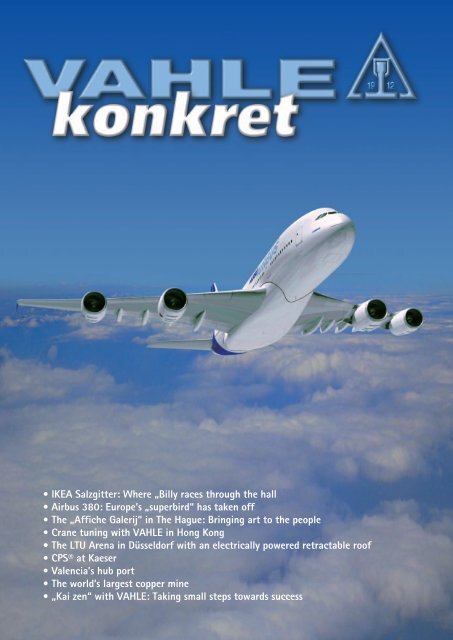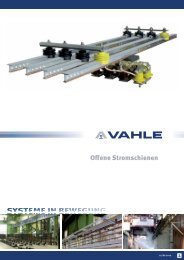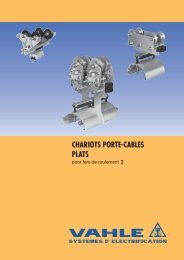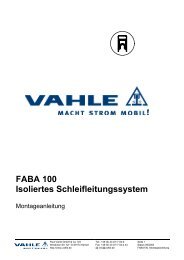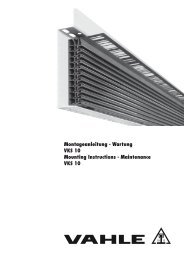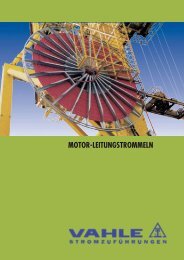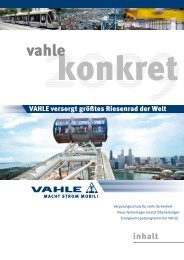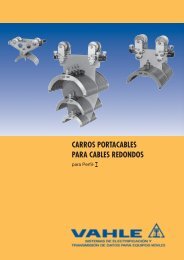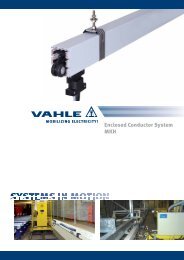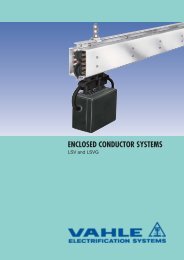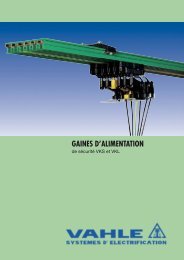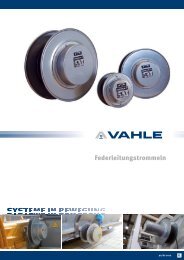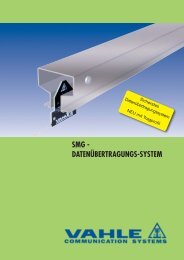VAHLE konkret 2005 deutsch Satz
VAHLE konkret 2005 deutsch Satz
VAHLE konkret 2005 deutsch Satz
Create successful ePaper yourself
Turn your PDF publications into a flip-book with our unique Google optimized e-Paper software.
• IKEA Salzgitter: Where „Billy races through the hall<br />
Airbus 380: Europe’s „superbird“ has taken off<br />
The „Affiche Galerij“ in The Hague: Bringing art to the people<br />
Crane tuning with <strong>VAHLE</strong> in Hong Kong<br />
The LTU Arena in Düsseldorf with an electrically powered retractable roof<br />
CPS® at Kaeser<br />
Valencia’s hub port<br />
The world’s largest copper mine<br />
„Kai zen“ with <strong>VAHLE</strong>: Taking small steps towards success
<strong>VAHLE</strong>-Service: Close to its customers all around the world<br />
Worldwide Partners<br />
<strong>VAHLE</strong> China: From<br />
a representative office<br />
to a Trading Company<br />
Xiang Li has been the new general<br />
manager of our subsidiary<br />
in Shanghai since March of<br />
this year. With him in charge,<br />
the already successful work<br />
will be continued with six additional<br />
employees.<br />
In order to live up to the challenges<br />
of the Chinese market,<br />
the previous „Representative<br />
Office“ was turned into an independent<br />
„Trading Company“<br />
starting July 1 st , 2004.<br />
This enables us to react more<br />
quickly and efficiently to the<br />
needs of the market and our<br />
customers.<br />
The activities particularly focus<br />
on automobile, steel and po-<br />
wer plant technology as well<br />
as storage technology.<br />
Additional emphasis is placed<br />
on port technology, because<br />
the largest manufacturer of<br />
container cranes, the company<br />
ZPMC, is based in Shanghai.<br />
Change of management - On August 1, <strong>2005</strong> Michael<br />
Pavlidis (left) was appointed as manager of technology (development,<br />
process planning and quality management). He thus follows<br />
the footsteps of Werner Runte (right), who is retiring after<br />
33 years with the company from Kamen. Managing Director Josef<br />
Hötte (center) bade farewell to the previous Technical Director.<br />
<strong>VAHLE</strong> on the<br />
Bosporus Strait<br />
After studying mechanical engineering<br />
in Germany, Mehmet<br />
Bebeck returned to Turkey in<br />
1985. He worked at a firm that<br />
built cranes and used many<br />
<strong>VAHLE</strong> products. Mehmet Bebeck<br />
was so convinced of their<br />
quality that he began to sell<br />
<strong>VAHLE</strong> products himself. In<br />
1999 he founded his own firm<br />
BM Makina and assumed the<br />
representation of <strong>VAHLE</strong> in<br />
Turkey.<br />
Along with companies who<br />
build cranes, steel plants, the<br />
automobile industry and the<br />
Turkish railway are among his<br />
clients.<br />
Satisfying these customers is<br />
Mehmet Bebeck’s main priority.<br />
Even if they have questions<br />
about a <strong>VAHLE</strong> product on a<br />
weekend, Bebeck and his staff<br />
will not hesitate to help them.<br />
Thanks to the extra efforts<br />
made and <strong>VAHLE</strong>’s good reputation,<br />
they have been able to<br />
increase the turnover from<br />
year to year.<br />
Successful in the Alps<br />
Andreas Bergthaler is the head<br />
of the <strong>VAHLE</strong> marketing company<br />
in Oberweis, Austria.<br />
From there the 39- year old<br />
and his young staff manage<br />
customer service activities in<br />
Austria and offer the whole array<br />
of products from Kamen.<br />
The main areas of application<br />
for <strong>VAHLE</strong> products are storage<br />
and conveyor technology, mechanical<br />
and plant engineering<br />
as well as the steel and mining<br />
industry. Special solutions for<br />
building stages, cable railways<br />
as well as rotating cupola<br />
roofs for observatories have<br />
also been successfully implemented.<br />
<strong>VAHLE</strong>’s regular clientel<br />
in Austria is continually expanding.<br />
Imprint<br />
Editor-in-chief:<br />
Thomas Hagermann,<br />
Paul <strong>VAHLE</strong> GmbH & CO KG,<br />
D-59172 Kamen (Germany)<br />
Tel.: 0049 2307 704 0,<br />
www.vahle.de<br />
Editorial staff: Klaus Kukuk,<br />
Jan-Uwe Ronneburger,<br />
Frank Niewerth<br />
Photos: Syndikat medienpool,<br />
Dagmar Frigge, Codelco, Airbus,<br />
AFT, Mauritius, HIT, viastore,<br />
Klaus Kukuk, G.P. Müller<br />
Design, Realization:<br />
Syndikat medienpool, Unna<br />
Print: B-W-H, Hannover
Viastore uses VKS10 in Germany’s largest IKEA storehouse<br />
Where „Billy“ races through the hall<br />
The city of Salzgitter, the<br />
third largest industrial<br />
base in Lower Saxony with a<br />
workforce of approximately<br />
54,000 has become a main<br />
hub for the region of South-<br />
East Lower Saxony. The<br />
„Ikea-Lager und Service<br />
GmbH“ (Ikea Storage and<br />
Service Ltd.) is based here.<br />
With almost 11,000 employees,<br />
the Swedish furniture<br />
house generates its largest<br />
country turnover in Germany<br />
and is Germany’s numberone<br />
name in furniture. Even<br />
today, the classic „Billy shelf<br />
system“ is still part of the<br />
basic configuration in many<br />
people’s first own apartment.<br />
Visiting the currently largest<br />
new building in Salzgitter’s industrial<br />
zone: the Swedish furnishing<br />
house has generously<br />
expanded its distribution center<br />
here. Mayor Helmut Knebel<br />
is proud of the large-scale project:<br />
„This investment is taking<br />
on a gigantic dimension. We<br />
are delighted that the cooperation<br />
between IKEA and the<br />
city has again stood the test of<br />
time.“<br />
New Construction<br />
Technology<br />
In the words of the managing<br />
director of IKEA Lager- und<br />
Service GmbH, Dieter Imberger,<br />
The ca. 32 meter tall shelf access machines look like scrawny<br />
yellow giants, when they zoom through the halls of the IKEA<br />
storehouse in Salzgitter. They are fed with electricity from the<br />
VKS 10 from <strong>VAHLE</strong>.<br />
the new hall comprises a surface<br />
of 92,000 square meters<br />
and is up to 32 meters high.<br />
One of its peculiarities is the<br />
new concrete and steel technology.<br />
150,000 pallet spots<br />
are available in the hall, and<br />
together with the 120,000 in<br />
the already existing building,<br />
there are now a total of<br />
270,000. Imberger: „To visualize<br />
this, you would have to<br />
image a row of such pallet<br />
spots from here to Dortmund.“<br />
With an overall surface of<br />
around 40 hectares, this main<br />
Ikea storage facility is nearly<br />
ten times the size of an Ikea<br />
furnishing store.<br />
Germany’s Largest<br />
Distribution Center<br />
Once completed, the distribution<br />
center in Salzgitter will<br />
become the largest in Germany<br />
and play a main role in IKEA’s<br />
process of expansion. According<br />
to IKEA, which currently<br />
has 33 stores, it is aiming for<br />
up to 60 stores.<br />
The distribution specialist viastore<br />
located in Stuttgart supplied<br />
the IKEA logistics center<br />
in Salzgitter with 14 viapal<br />
shelf access machines, the pallet<br />
conveyor technology, the<br />
shelf steel structures for approximately<br />
85,000 pallets as<br />
well as the material flow operating<br />
devices. Up to 10,000<br />
pallets are supposed to be<br />
transported in and out every<br />
day.<br />
Reliable VKS10<br />
To make certain that everything<br />
runs smoothly in the gigantic<br />
pallet storage facility,<br />
the supplier viastore uses<br />
<strong>VAHLE</strong> products. The new safety<br />
conductor VKS10 guarantees<br />
a reliable and safe supply<br />
of electrical current to the sor-<br />
ting machines. This is also a<br />
must when the shelf access<br />
machines zoom through the<br />
storage corridors at speeds of<br />
up to 200 meters per minute.<br />
However, not only the reliability<br />
of the products from Kamen<br />
has won over the engineers<br />
from Stuttgart, but also the<br />
price-quality aspect.<br />
Time-tested product<br />
As of now, the cooperation<br />
between <strong>VAHLE</strong> and viastore<br />
has also stood the test of time<br />
at other installations by the<br />
logistic specialist.<br />
The VKS10 conductor system<br />
can accommodate up to 10<br />
copper conductors in its housing.<br />
Due to the low phase distance<br />
of only 14 mm, a conductor<br />
system has been developed<br />
which is very compact.<br />
With parallel connection of<br />
conductor rails a maximum<br />
continuous current of 280 A<br />
can be transmitted.<br />
A special support sheet metal<br />
profile allows the user support<br />
distances of up to 4.5 meters.<br />
This eliminates complicated<br />
on-site support construction<br />
and reduces installation costs.
The Airbus A380 is moving into new dimensions<br />
Europe’s „superbird“ has taken off<br />
and Great Britain. Six thou- with the control signals are<br />
sand people are working on it, transmitted using a 30-con-<br />
not including the ca. 100 supductor cable on a <strong>VAHLE</strong> motor<br />
pliers worldwide. The gigantic cable reel. (I hope the previous<br />
parts are brought to Toulouse sentence is correct as I don’t<br />
by ship and truck, where they have the original, also I cannot<br />
are assembled.<br />
make sense of the following<br />
sentence)! The cable tray in an<br />
Engine tests<br />
only 40-millimeter wide cable<br />
carrier is ensured by the appropriate<br />
conduits.<br />
Precision is the main imperative<br />
not only when building the<br />
A380, but also in all of<br />
<strong>VAHLE</strong>’s solutions.<br />
Europe is celebrating its<br />
most successful industrial<br />
project: the giant jumbo A<br />
380 - a new airplane that<br />
has taken on dimensions<br />
which were hardly imaginable<br />
a few years ago. Yet in<br />
this very year – ten years after<br />
the initial idea – three<br />
specimen of the Airbus A380<br />
became reality: 73 meters<br />
long, 24 meters high, a<br />
wingspan from the tip of the<br />
left to right wing of 79.80<br />
meters with a wing surface<br />
of 845 square meters. Now<br />
for the first time, a jet has<br />
three decks, one for cargo<br />
and baggage, and two for<br />
the nearly 800 passengers<br />
depending on the seating arrangement.<br />
It is as if two<br />
large airplanes were packed<br />
into one. Airports must adjust<br />
to the magnitude of this<br />
airplane.<br />
On April 27th, <strong>2005</strong> the „big<br />
goose“, as the A380 is also<br />
called by engineers, took off<br />
for its first flight in front of<br />
thousands of curious onlookers.<br />
The first impression was disappointing.<br />
The super bird does<br />
not appear to be gigantic.<br />
Maybe Airbus should put a<br />
small A318 next to it, so that<br />
people can understand the dimensions<br />
of it. It is the gigantic<br />
hall painted silver-blue at<br />
the Airbus site that triggers<br />
the illusion. The building – one<br />
of the largest in Europe – is<br />
five-hundred meters long, 250<br />
meters wide, and 46 meters<br />
high. It also offers 34,000<br />
square meters of office space<br />
on six floors.<br />
Only gradually do the onlookers<br />
realize the size of the<br />
A380. From the gallery at the<br />
height of the tail unit it becomes<br />
apparent what a colossus<br />
is standing there in the hall.<br />
The workers and engineers<br />
pottering about 20 meters below<br />
on the ground look like<br />
ants. The airplane requires a<br />
surface of 100 x 100 meters,<br />
while the working platforms to<br />
the left and right of the plane<br />
are elevated five floors.<br />
A product from<br />
all over Europe<br />
The A380 is a product that is<br />
as European as almost no<br />
other. The individual parts for<br />
the superbird are manufactured<br />
at 16 sites between Spain<br />
At the site the airplane manufacturer<br />
tests not only the preliminary<br />
models, but also all<br />
subsequent airplanes of the<br />
series after assembly. A new<br />
test stand has been built at<br />
Toulouse Airport for engine<br />
tests and test runs. This test<br />
stand has a diameter of over<br />
100 meters.<br />
Twenty-meter high walls and<br />
gates protect the outside<br />
world from the sound. The two<br />
giant gates with their own engines<br />
are fed by two <strong>VAHLE</strong><br />
cable carrier assemblies. The<br />
reliable W45 cable carriers<br />
were installed for this purpose.<br />
During the test run of the<br />
enormous Rolls Royce engines,<br />
the thrust must be directed<br />
upwards. Six connected, maneuverable<br />
deflectors with frequency<br />
controlled motors are<br />
in charge of this task. The<br />
electrical current supply along<br />
The <strong>VAHLE</strong> system can be<br />
recognized in the crosssection<br />
profile of the machine.<br />
The W45 FR cable carrier assemblies<br />
have a new kind of<br />
clamping profile for flat and<br />
round cables. With the combination<br />
of the basic clamping<br />
profile and one or more enhanced<br />
profiles - 6 mm index – it is<br />
possible to clamp together<br />
round cables of different diameters<br />
and flat cables of different<br />
sizes.
The „Affiche Galerij“ in The Hague<br />
Bringing Art<br />
to the People<br />
In the past decades cultural<br />
activities have been developed<br />
in public places in The<br />
Hague, which can hardly be<br />
found anywhere else in the<br />
Netherlands.<br />
Music festivals, outdoor cinema,<br />
the famous sculpture<br />
exposition in the city and of<br />
course the world-famous<br />
firework festival on the beach<br />
in the suburb of Scheveningen<br />
attract culture buffs<br />
to the Oranje city every year.<br />
Since October 2004 the center<br />
has a new attraction. In<br />
the long awaited underground<br />
„Deluxe“ station of<br />
the city railway at the Spuiplein<br />
square there is a continuous<br />
poster exposition, the<br />
„Affiche Galerij“ or poster<br />
gallery.<br />
At the gallery, the historic posters<br />
hang behind a two-meter<br />
high glass wall on a surface of<br />
more than 150 meters. Up to<br />
six times a year, the exhibits,<br />
which were compiled according<br />
to topic by the project director<br />
Wendy Lauw from the<br />
Hague City Archive, are rotated:<br />
„Sixty posters in the illuminated<br />
frames then have to<br />
be changed and hung up<br />
again. Together with <strong>VAHLE</strong>,<br />
the Dutch star architect Rem<br />
Koolhass has developed a<br />
simple and safe system so that<br />
this can be done quickly and<br />
easily. The suspensions of the<br />
frames are threaded in a continuous<br />
guide rail and pushed<br />
into their position by hand. In<br />
order to illuminate the pictures<br />
equally without a glare, the<br />
frames have a built-in indirect<br />
lighting system. Thus, the<br />
electrical current logically has<br />
to be mobile and carried along<br />
with the exhibit.“<br />
Who could have developed a<br />
better solution for this than<br />
<strong>VAHLE</strong>. It’s not for nothing<br />
that the firm’s slogan is:<br />
„<strong>VAHLE</strong> makes electricity mobile“.<br />
While 156 meters of the<br />
S2 carrier were used as guide<br />
rails, the the KSL enclosed<br />
conductors were used to supply<br />
electricity to the illuminated<br />
frames. The collector cables<br />
had to be adjusted to the curves<br />
and bulges of the walls according<br />
to the artists’ preferences.<br />
Flexible to<br />
customers’ wishes<br />
But not only that. The classic<br />
<strong>VAHLE</strong>-green of the conductors<br />
was out of the question<br />
for Koolhaas. Flexibility and<br />
customer service is one of the<br />
great strengths of the firm<br />
from Kamen. This is how VAH-<br />
LE satisfied the needs of the<br />
architect. An eye-catching<br />
orange powder coating was<br />
applied to the carrier rail and<br />
the conductor system was tinted<br />
to match the brown color<br />
of the steel construction. At<br />
any rate Wendy Lauw is highly<br />
Thanks to the bright floors, the openings in the ceiling for daylight and of course the „Affiche<br />
Galerij“ with its 60 illuminated posters, no one will feel trapped in the station at the Spuiplein.<br />
satisfied with the installation:<br />
„It is easy to handle and works<br />
absolutely flawlessly up to<br />
now. I think we will be able to<br />
use it for many more years without<br />
difficulties, not only in<br />
order to relieve the passengers<br />
of that nightmarish feeling<br />
that is often associated with<br />
an underground station, but<br />
also to continue offering them<br />
continually changing art.“<br />
The fact that the people feel<br />
that they are in good hands in<br />
this underground station, certainly<br />
also has to do with the<br />
unusually bright wooden floors<br />
and the daylight slots. However,<br />
the „Affiche Gallerij“ of<br />
the city archive adds an additional<br />
highlight to the highly<br />
successful architecture. The<br />
proof: as soon as the posters<br />
are in their place, the first<br />
photographers are there to<br />
take pictures of them. The<br />
blond archivist director smiles<br />
with satisfaction, when she<br />
points to the picture aficionados<br />
to help her prove her<br />
point: „This is what we experience<br />
every time. You have to<br />
bring art to the people and<br />
then they will take pleasure in<br />
it.“<br />
<strong>VAHLE</strong>’s KSL PVC enclosed<br />
multiple conductor systems are<br />
insulated safety conductors for<br />
crane trolleys and material<br />
handling equipment, suspension<br />
tracks, hoists, electrical<br />
tools, automated storage and<br />
retrieval installations, as well<br />
as many applications in which<br />
electrical current is supplied to<br />
mobile users. They are suitable<br />
for indoor and outdoor facilities.<br />
They distinguish themselves<br />
by the fact that they require<br />
little space, are corrosion-resistant<br />
and easy to install.
Crane tuning with <strong>VAHLE</strong> in Hong Kong<br />
Space for more containers<br />
Even in the early 18th<br />
century, Europeans had<br />
come to cherish silk, tea, and<br />
spices from China. Once the<br />
English East India Company<br />
had first advanced as far as<br />
Canton in 1699, a flourishing<br />
system of trade with<br />
China quickly developed. This<br />
gave rise to Hong Kong as a<br />
trans-shipment center.<br />
Even today, the logistics industry<br />
of the Chinese special administration<br />
region is considered<br />
to be one of the main pillars<br />
of the economy. Tea, silk<br />
and spices made room for clothing,<br />
electronics, IT and toys a<br />
long time ago. The „nerve system“<br />
of Hong Kong is Victoria<br />
Harbour (located between the<br />
island Hong Kong and the<br />
Kowloon Peninsula), which is<br />
60 km 2 in size. It is among the<br />
most beautiful natural harbors<br />
and – measured by its turnover<br />
– it is at the very top of the<br />
world rankings; its computeroperated<br />
container terminal<br />
„Kwai Chung“ has the highest<br />
turnover on earth, 20.4 million<br />
TEU.<br />
Help in facing<br />
the competition<br />
Hong Kong still maintains a<br />
clear lead, but stiff competition<br />
for the logistics center has<br />
emerged, in particular, in the<br />
neighboring metropolis Shenzhen<br />
with more than a million<br />
residents. The rapidly increa-<br />
sing turnover capacities for<br />
containers in the Chinese special<br />
economic zone are posing<br />
serious difficulties to the Hong<br />
Kong planners. In light of the<br />
competition between these<br />
two rivals, any good idea is<br />
highly welcome. Thus, it is no<br />
surprise that the port operators<br />
of the Hong Kong International<br />
Terminal HIT have willingly<br />
opened their doors to<br />
the crane converter PBI from<br />
Hürth near Cologne with its<br />
latest technical device. The<br />
idea is simple and practical.
Inhospitable environs are no<br />
bother for <strong>VAHLE</strong> professional<br />
solutions.<br />
For conventional cranes, the<br />
stacking height of containers<br />
is limited by the cable loop<br />
hanging down. After all, the<br />
electricity and data cables<br />
need to be able to extend.<br />
The small innovator from the<br />
Rhineland conducted experiments<br />
with the <strong>VAHLE</strong> insulated<br />
conductor U35 with an<br />
aluminum stainless steel de-<br />
sign and the data transmission<br />
system SMG from <strong>VAHLE</strong>, in<br />
order to replace the cables,<br />
which were subject to wear<br />
and tear, with a more modern<br />
solution. By using the U 35 insulated<br />
conductor rail in conjunction<br />
with SMG mobile data<br />
transmission, Hurth Co. was<br />
able to create additional free<br />
space below a container crane.<br />
What does not seem to be so<br />
groundbreaking at first sight<br />
begins to make more sense<br />
when one takes into consideration<br />
how little space is available<br />
in a container port working<br />
at full capacity. If there is<br />
limited room in terms of width,<br />
the solution has to be found<br />
aloft. By removing the cable<br />
carrier assemblies, up to three<br />
meters and more additional<br />
Removing the cable carrier assemblies creates – among<br />
other things – additional space below the crane for more<br />
stacking height in the container port.<br />
stacking height were gained –<br />
enough for a further layer of<br />
containers.<br />
By combining the <strong>VAHLE</strong> products,<br />
it was no longer necessary<br />
to replace the worn out<br />
cables, which otherwise must<br />
be done approximately every<br />
three years, and the crane trolleys<br />
can be driven faster, in order<br />
to bring the containers to<br />
the right position. This entails<br />
further significant benefits besides<br />
the additionally gained<br />
storage space.<br />
Because the „tuning“ of the<br />
test crane went so well, PBI is<br />
already planning on converting<br />
two more cranes. These will<br />
certainly not be the last. More<br />
than 40 cranes are still standing<br />
in this area of the terminal<br />
alone.<br />
The SMG data transmission<br />
system is suitable for interference-free<br />
data transfer at<br />
high data rates in automation<br />
technology. It can be adapted<br />
to nearly all conventional<br />
computers or SPS-interfaces.<br />
Its robust structure also allows<br />
for using the system under<br />
more harsh operational and<br />
environmental conditions. In<br />
combination with the <strong>VAHLE</strong><br />
U35 power conductors, SMG is<br />
a reliable and cost effective<br />
system’s integration.
<strong>VAHLE</strong>-Technology closes the giant retractable roof with precision<br />
LTU arena: For any weather<br />
Düsseldorf has a new<br />
stadium of technological<br />
superlatives. The LTU arena<br />
has more than 51,500 seats<br />
and offers space for up to<br />
65,000 spectators including<br />
indoor space at music concerts.<br />
A gigantic home not<br />
only to the American football<br />
team Rheinfire.<br />
The LTU arena has an enormous,<br />
closable roof, which is<br />
235 meters long, 201 meters<br />
wide and 8000 tons when<br />
closed. The roof elements, two<br />
190 meter long steel beams<br />
that weigh 1650 tons each,<br />
are an essential part of the<br />
structure.<br />
With a push of a button, they<br />
open or close the 110 x 70 meter<br />
opening of the roof in just<br />
30 minutes. Thus, rain or snow<br />
cannot disrupt any concert or<br />
football match.<br />
In order to do this, massive<br />
loads must be moved: after all<br />
each of the two halves weighs<br />
630 tons, is 127 meters long,<br />
36 meters wide and nine meters<br />
high. The roof is moved<br />
with the help of electric mo-<br />
tors. The contact surface for<br />
the retractable roof is provided<br />
by the two main carriers of the<br />
roof. As soon as it begins to<br />
move along the toothed wheel<br />
tracks, there is an acoustic<br />
warning signal. The arena can<br />
be completely darkened inside.<br />
The openings below the roof<br />
are then also closed with sunblinds.<br />
Precision demanded<br />
When precision is in demand,<br />
<strong>VAHLE</strong> is never far. The proved<br />
and tested professionals from<br />
Kamen were entrusted with<br />
the task of setting up the electrical<br />
current and the data<br />
transmission system for the<br />
enormous retractable roof. For<br />
its realization, a joint solution<br />
consisting of the SMG data<br />
transmission system and the<br />
LSV aluminum multiple enclosed<br />
conductor system was<br />
installed. Time-tested and reliable.<br />
Both halves of the giant roof<br />
were assembled beforehand.<br />
Each weighing 550 tons, both<br />
In any weather, the LTU arena offers ideal conditions, as<br />
<strong>VAHLE</strong> technology assists in dependably closing the roof.<br />
parts of the retractable roof<br />
for the new Rhine arena in<br />
Stockum were securely anchored<br />
at a height of more than<br />
50 meters. For lifting, two giant<br />
special heavy load cranes<br />
were used, which could each<br />
lift a massive load of 275 tons<br />
with a 25 meter cantilever.<br />
Both halves of the roof were<br />
pre-assembled since February<br />
2003 from around 72 pieces of<br />
steel. The largest pieces had to<br />
be transported to the construction<br />
site by ship.<br />
Heated or open air<br />
The LTU arena possesses a<br />
highly modern and unique heating<br />
system. With a closed<br />
roof, visitors can sit in the<br />
stands in at least 60 F degrees<br />
temperature, even in winter.<br />
Air heating, gas radiators and<br />
floor heating provide for this.<br />
In doing so, 100 ventilators<br />
move 900,000 cubic meters of<br />
air per hour. Overall, the climate<br />
control and ventilation<br />
technology of the LTU arena ca<br />
move 3 million cubic meters of<br />
air per hour. Thus, large events<br />
can be held in the LTU arena<br />
throughout the entire year, independent<br />
of the weather. No<br />
other stadium in Germany can<br />
match that. The 8000 square<br />
meter grass surface for the LTU<br />
arena was delivered from Holland<br />
in „jumbo rolls“ measuring<br />
20 meters long, 1.20 meters<br />
wide and 30 millimeters<br />
thick in a total of 20 truck<br />
loads. Under the grass 42 cm<br />
thick mixture of sand, lava and<br />
peat is found.<br />
The compact LSV aluminum<br />
enclosed multiple conductor<br />
system is suitable for indoor<br />
and outdoor installations. It is<br />
used as a current feed for cranes,<br />
monorails, hoists, electrical<br />
tools, machine tools, automated<br />
storage and retrieval<br />
systems and other mobile consumers<br />
of electrical current,<br />
even at higher temperatures.
Contractless power supply line CPS® in compressor production<br />
Kaeser is on the road to<br />
success with <strong>VAHLE</strong> quality<br />
In road construction, even<br />
laymen are quick to recognize<br />
mobile compressors<br />
from Kaeser. Still, that is<br />
only one application area<br />
where compressed air is used.<br />
Wherever compressed air<br />
must be generated, produced<br />
or distributed, one can encounter<br />
the bright yellow<br />
power plants of the Franconian<br />
manufacturer.<br />
Today, Kaeser is a world-wide<br />
leading manufacturer of compressors<br />
and products for compressed<br />
air technology, employing<br />
more than 3000 people<br />
and is represented in over 70<br />
countries and on all continents<br />
through a competent marketing<br />
and service organization.<br />
The company operates one of<br />
the largest fully automated<br />
plants for the production of<br />
compressors of all types at its<br />
German headquarters in Coburg.<br />
In order to satisfy the high demand<br />
which the Franconian<br />
company places on internal<br />
transport, AFT, an automizati-<br />
on and materials handling<br />
technology company based in<br />
Schopfheim uses components<br />
from <strong>VAHLE</strong>.<br />
More effective<br />
production<br />
To make production at the<br />
main facility in Coburg even<br />
more effective, a section for<br />
driverless floor transportation<br />
vehicles was installed, which is<br />
distributed over two floors.<br />
On a stretch of 510 meters in<br />
length (310 m in the ground<br />
floor, 200 m in the upper level),<br />
ten vehicles transported<br />
the compressors after completion<br />
to stations such as weight<br />
and contour control and to the<br />
transfer stations for the storage<br />
and retrieval facility,<br />
which is located in a separate<br />
building.<br />
The track system consists of<br />
two parallel tracks on which<br />
the vehicles travel fully automatically,<br />
both forwards and<br />
backwards. Four elevators<br />
(hoists from the ground floor<br />
to the upper floor) and 15<br />
track switches connect the<br />
track sections.<br />
High flexibility<br />
The tracks can be changed at<br />
any time to achieve higher flexibility.<br />
The electrical current<br />
for the vehicles is transmitted<br />
inductively via the contactless<br />
power supply CPS® manufactured<br />
by <strong>VAHLE</strong>.<br />
The entire installation is supplied<br />
by a <strong>VAHLE</strong> primary inverter<br />
P145 with 45 kW, which<br />
is located on the ground floor.<br />
Each vehicle carries one pallet,<br />
which is loaded and unloaded<br />
from the side. It is equipped<br />
with steerable axles as well as<br />
with two <strong>VAHLE</strong> track guidance<br />
sensors for each direction<br />
of travel and two Ultra Caps<br />
(24V) with a 500 farad load<br />
volume (a type of quick loading<br />
battery or „large“ capacitor).<br />
These are supplied with electrical<br />
current (up to 125A/<br />
24V0 by a <strong>VAHLE</strong> flat pickup<br />
PU09 (3 kW) with control electronic,<br />
mounted on the carria-<br />
As if driven by a ghost, the floor transport carriers precisely deliver components to the next<br />
assembly station – the contactless current supply CPS® <strong>VAHLE</strong> makes it possible.<br />
ge. Each vehicle has its own<br />
„intelligence“ on board and receives<br />
the destination instructions<br />
via RF transmission;<br />
transponders in the floor assure<br />
local accuracy<br />
This <strong>VAHLE</strong> CPS installation<br />
was designed and developed to<br />
meet specific design criteria<br />
postulated by Kaeser. The system<br />
has operated trouble free<br />
for over a year with the <strong>VAHLE</strong><br />
products. Therefore, Kaeser is<br />
contemplating an expansion to<br />
achieve even faster transport<br />
of goods because of increased<br />
volumes.<br />
CPS® is the <strong>VAHLE</strong> system for<br />
contractles power supply. In<br />
contrast to customary methods<br />
of supplying electrical current<br />
to moveable equipment CPS®-<br />
Technology offers the following<br />
advantages: low maintenance<br />
due to a lack of wear parts,<br />
clean and noiseless operation,<br />
unlimited travel speed, utilization<br />
is also possible with complex<br />
track layouts and under<br />
adverse environmental conditions,<br />
high track guidance tolerance,<br />
the possibility of integrated<br />
battery charging function,<br />
integrated inductive track<br />
guidance and data communication,<br />
high degree of efficiency.
The trench conductor systems installed in the wharf have proven themselves for years.<br />
Valencia claims its place at the top with <strong>VAHLE</strong> quality<br />
Higher output for the „City of the Sea“<br />
Valencia lies on the Spanish<br />
Mediterranean<br />
coast, approximately 350 km<br />
south of Barcelona at the<br />
mouth of the Turia river. As<br />
an old port city on the Mediterranean,<br />
Valencia is full of<br />
maritime stories. It is therefore<br />
often called „the City of<br />
the Sea“. In 2007, the legendary<br />
American’s Cup of sailing<br />
is slated to start here.<br />
With 746,000 residents, the<br />
provincial capital of Valencia is<br />
the third largest city in Spain<br />
after Madrid and Barcelona. In<br />
addition to the traditional consumer<br />
goods industries such as<br />
textiles, wood, ceramics and<br />
footwear, large multinational<br />
companies have settled in the<br />
economic region of Valencia<br />
that are specialized in the ma-<br />
nufacture of automobiles, automobile<br />
accessories, engineering,<br />
iron and steel extraction,<br />
glass, plastic and petrochemicals.<br />
In addition, the region<br />
also has a large number of<br />
technology based companies,<br />
which provide the multinational<br />
companies with supplies<br />
and services.<br />
Top place in Spain<br />
In addition, Valencia companies<br />
also export a wide array<br />
of agricultural products and<br />
the traditional local goods like<br />
ceramic tiles, footwear and<br />
textiles.<br />
Valencia is the second largest<br />
exporter in Spain. For that purpose,<br />
a high-capacity port is a<br />
logical requirement. The port<br />
of Valencia transacts 20% of<br />
Spanish exports and is the largest<br />
container port in Spain<br />
overall with 28 million tons of<br />
freight per year.<br />
The port never sleeps<br />
In order to achieve this accomplishment,<br />
the container<br />
cranes are utilized around the<br />
clock. The port never sleeps.<br />
The requirements on technology<br />
are continuously subjected<br />
to a difficult test in this raw<br />
environment. Salt water and<br />
dirt afflict the cranes and their<br />
power train components. It is<br />
therefore not surprising that<br />
only proven products can survive<br />
here in the long run.<br />
Such products include the<br />
trench conductor system from<br />
<strong>VAHLE</strong>. Since 1997, a 1.5 kilo-<br />
The <strong>VAHLE</strong> slotless trench<br />
conductor system has been<br />
manufactured since 1925. It is<br />
used for dock side cranes, loading<br />
bridges, locomotive transversers,<br />
etc., where an above<br />
ground conductor system<br />
would be obstructive. The<br />
trench conductor system is installed<br />
below ground parallel<br />
to the dockside and can<br />
follow all incidental curves of<br />
the crane rail.<br />
The conductor trench is normally<br />
laid in concrete. The<br />
trench conductor system is<br />
covered over the entire length<br />
with steel plates supported on<br />
both sides by edge steel<br />
profiles.The plates are hinged<br />
with an above or below ground<br />
hinges.<br />
meter long trench is in use<br />
with the proven U30 conductors.<br />
Eleven giant container<br />
cranes are supplied with electrical<br />
current from under the<br />
ground.<br />
Due to the reliability of the<br />
system, another 500 meters<br />
were installed in the past year,<br />
in order to expand the reach of<br />
the cranes to an additional<br />
loading wharf.<br />
An additional 720 meters of<br />
below-ground trenches will be<br />
constructed this year. Due to<br />
the higher capacity requirements,<br />
the larger type U40 U<br />
conductors are being used.<br />
Moreover, high voltage of<br />
11,000 Volts will be utilized.<br />
Thus, Valencia will also be able<br />
to claim its top position in<br />
Spain in the future.
The world’s<br />
largest copper<br />
mine<br />
Back to<br />
its origins<br />
At first sight, the mind re<br />
fuses to understand what<br />
the eyes see in the thin air of<br />
the high mountains of Chuquicamata:<br />
the largest open<br />
pit copper mine in the world<br />
located nearly 3000 meters<br />
high in the north of Chile<br />
can be identified even dozens<br />
of kilometers away.<br />
„Pies“ are what the natives call<br />
the giant mining dumps, which<br />
push up like lower mountain<br />
ranges from the pre-Andes<br />
into the withered landscape.<br />
Not until houses and cars enter<br />
the scene can the sheer<br />
magnitude of this mine of superlatives<br />
be fathomed, which<br />
evidently can be recognized<br />
from space with the naked eye.<br />
The pride of Chile produces<br />
600,000 tons of copper per<br />
year and belongs to the stateowned<br />
copper company Codelco,<br />
which generates eight percent<br />
of the state budget alone.<br />
Since 1915 1.6 trillion tons of<br />
stone have been blasted out of<br />
the mountains in Chuquicamata<br />
approximately 1600 kilometers<br />
to the north of the capital<br />
of Santiago and dumped<br />
into the mining dumps after<br />
removing the copper.<br />
Like an excessively large football<br />
stadium, the mine today is<br />
4.3 kilometers long, 3 kilometers<br />
wide, and 835 meters<br />
deep. At the bottom of the<br />
mine, mechanical diggers,<br />
which are hardly recognizable<br />
with the naked eye, load the<br />
blasted stone onto giant<br />
trucks, which then transport it<br />
to the surface on serpentines.<br />
The giant trucks in the enormous strip mine of Chuquicamata look like toy cars.<br />
Raw materials<br />
for <strong>VAHLE</strong><br />
For many years, the state copper<br />
manufacturer has relied on<br />
<strong>VAHLE</strong> products for mining activities.<br />
These products then<br />
return as finished products to<br />
where their copper core has its<br />
origins. Even today, insulated<br />
U40 solid copper conductor<br />
rails provide for the reliable<br />
supply of electricity to the<br />
processing facilities. They are<br />
especially equipped for the difficult<br />
conditions in the melting<br />
plants and have a good reputation<br />
among Chileans due to<br />
their robustness and because<br />
they are easy to handle. This<br />
reliability is also in demand for<br />
the coming years.<br />
2.5 billion tons of reserves are<br />
still stuck in the earth, which<br />
are enough for thirty more years.<br />
And then? The Escondida<br />
mine is already in the process<br />
of surpassing the Chuquicamata<br />
mine, because „Chuqui“,<br />
as it is affectionately called is<br />
only a part of the state copper<br />
company Codelco. It supplies<br />
twenty percent of the copper<br />
produced worldwide and – like<br />
saltpeter once was – it is the<br />
lifeline of the Chilean state<br />
budget: in the sixties and seventies<br />
the Frei and Allende<br />
governments put the copper<br />
industry under state control<br />
and the military government<br />
under General Pinochet kept it<br />
that way.<br />
No longer normal<br />
All numbers and figures concerning<br />
this mine are almost<br />
surreal. Every shovel for the gigantic<br />
mechanical diggers –<br />
priced at 10 million Euros a piece<br />
– grabs 110 tons of boulders.<br />
The trucks have a load<br />
capacity of 400 tons. At 3300<br />
horse-power, the 110 vehicles<br />
hum around the clock with<br />
their precious cargo up to the<br />
rock grinders and furnaces at<br />
the surface. Every one of the<br />
four tires costs as much as a<br />
mid-sized car and the diesel<br />
consumption of 400 liters per<br />
100 kilometers is also somewhat<br />
higher than normal.<br />
From ore to metal<br />
First the stone is grinded<br />
down. Then the grinded stone<br />
is chemically treated in a basin:<br />
this is where the iridescent<br />
green broth with black air<br />
bubbles simmers. Coppery mud<br />
settles at the bottom and<br />
flows into the foundry. There<br />
the mud is heated in a giant<br />
furnace. The fire glows in a<br />
turquoise color. The glowing<br />
metal is poured into molds and<br />
cooled off with running water.<br />
The product is called „Blister“<br />
and consists of 99 percent<br />
copper. The still steaming bullions<br />
are piled onto containers<br />
and then driven from here to<br />
the port.<br />
Codelco is already drawing up<br />
plans for an even much more<br />
gigantic mine, next to which<br />
the existing excavation would<br />
look like a mid-sized dent. In<br />
the next 20 years Chuquicamata<br />
is supposed to be expanded<br />
to a length of 20 kilometers.<br />
Until then, as much rock<br />
is supposed to be moved as in<br />
the past 90 years together.<br />
Insulated U40 conductor rails<br />
provide electricity for many<br />
TECHNIKDETAILS<br />
applications such as heavy<br />
cranes and container bridges<br />
(crane Auch das and crane Bild steht trolleys), stell-<br />
high-performance vertretend für ein monorails, anderes<br />
coking Foto. Dies plant ist machinery Blindtext. among Er<br />
others. hat keinerlei The insulating Bezug shroud zum<br />
in Inhalt, both the sondern standard stellt and allein heatresistant<br />
die Textmenge, design is Schriftart resistant to<br />
gasoline, und -größe, mineral Zeilenabstand<br />
oil, grease,<br />
sodium hydroxide 50%, con-<br />
und Umbrauch dar.<br />
centrated salt acid and sulfuric<br />
acid 50%.
„Kai zen“ with <strong>VAHLE</strong>:<br />
Taking small steps<br />
towards success<br />
There are many ways for<br />
small and mid-sized businesses<br />
to increase their competitiveness,<br />
for example by<br />
creating their own company<br />
profile and by designing their<br />
products attractively.<br />
Special attention in this regard<br />
should be given to the<br />
employees’ creative potentials<br />
and diverse ideas. Many<br />
small and mid-sized companies<br />
can find „hidden reserves“<br />
here.<br />
Through its workshops, <strong>VAHLE</strong><br />
has begun a „kai zen“ process<br />
this year. The driving force behind<br />
this form of management<br />
is Michael Pavlidis, <strong>VAHLE</strong><br />
Technical Director.<br />
? Mr. Pavlidis, what does kai<br />
zen mean in German?<br />
! The Japanese word kai zen<br />
consists of the two terms KAI<br />
= change and ZEN = for the<br />
better. This thus describes the<br />
aim of the process – the<br />
endeavor to constantly scrutinize<br />
and improve products, activities,<br />
business processes and<br />
customer relations. According<br />
to the kai zen philosophy it is<br />
not so much about „great<br />
ideas“, rather the multitude of<br />
small and simple suggestions.<br />
? Where are these ideas supposed<br />
to come from?<br />
! These suggestions for improvement<br />
are expected from all<br />
the employees of the firm, so<br />
that the products and working<br />
processes are continually further<br />
developed within the framework<br />
of a so-called<br />
„Continual Improvement Process“<br />
(CIP).<br />
One might exaggerate a bit<br />
and describe it as follows: a<br />
one-percent improvement of<br />
one hundred things in the<br />
business is better than a 100<br />
percent improvement of one<br />
thing.<br />
? What is your understanding<br />
of a creative employee?<br />
! A creative employee is someone<br />
who continually thinks<br />
while he or she is doing what<br />
he or she does. Someone who<br />
doesn’t let the things just run,<br />
but also feels responsible for<br />
the quality that he or she manufacturers,<br />
someone who becomes<br />
active and doesn’t just<br />
say: „I know that that is bad,<br />
but we have a quality assurance<br />
system. They will figure it<br />
out“.<br />
? How can <strong>VAHLE</strong> use the creativity<br />
of its employees?<br />
Michael Pavlidis discusses the concrete implementation of the<br />
results on site with two participants of the workshop.<br />
! We have already set our<br />
sights on several areas this<br />
year and brought the employees<br />
together in small groups<br />
in order to bundle together<br />
ideas and put them into<br />
practice directly.<br />
? Why small groups?<br />
! Better suggestions are frequently<br />
made in small groups.<br />
More sensible and practicable<br />
suggestions can be reached<br />
when they are drawn up by<br />
working groups and discussed<br />
within them.<br />
? What do you pay particular<br />
attention to with regard to the<br />
improvements?<br />
! The primary goal is the reduction<br />
of muda (waste).<br />
Muda refers to everything that<br />
is unnecessary. Unused storage<br />
space, unnecessary trips, friction<br />
loss when working together<br />
and much more.<br />
The main goal is not correcting<br />
errors, rather avoiding errors<br />
and striving for zero-defect-<br />
solutions. The motto here is:<br />
quality is when the customer<br />
comes back, and not the product.<br />
? What do you hope to achieve<br />
with the „running process“?<br />
! The benefits are obvious: lower<br />
costs, reducing allowable<br />
defects, reducing stock, saving<br />
space, improved quality and<br />
maintenance during production.<br />
For the employees I expect<br />
an improved business climate,<br />
better communication,<br />
self reliant colleagues and improved<br />
work ethic.<br />
? Are there any first results?<br />
! Yes, as a result of the workshop,<br />
we were able to avoid<br />
moving into a new hall by<br />
using space more optimally. I<br />
have to clearly emphasize one<br />
thing here: these successes<br />
would not have been possible<br />
if our employees had not cooperated<br />
excellently and adapted<br />
to the new approach so<br />
well.<br />
Representatives from all over the world met at the <strong>VAHLE</strong> international conference to gain insights on current developments<br />
in the firm. The main focus was placed on the intensive training of the sales force as well as the presentation of innovations and<br />
further developed products. While exchanging professional information with one another, the German and international guests also visited<br />
several cultural sites in the Ruhr region, where they had extra time to enjoy each others’ company.


